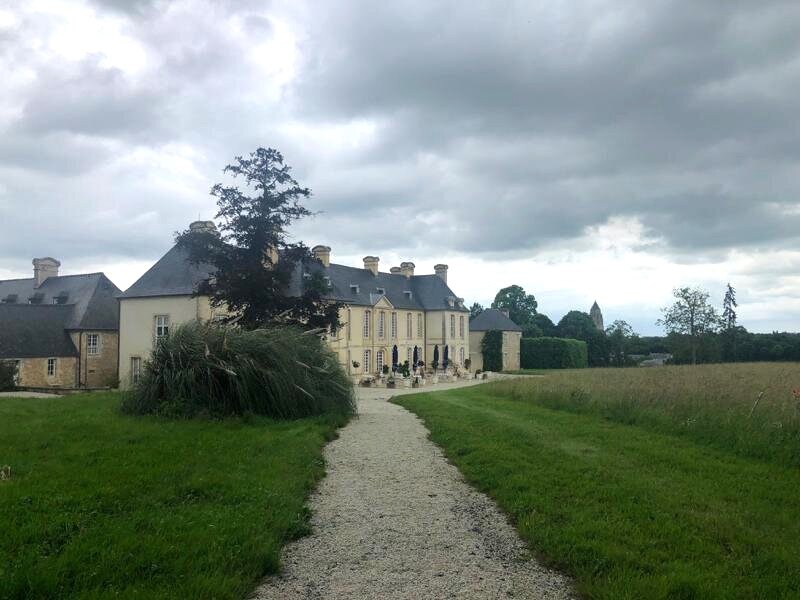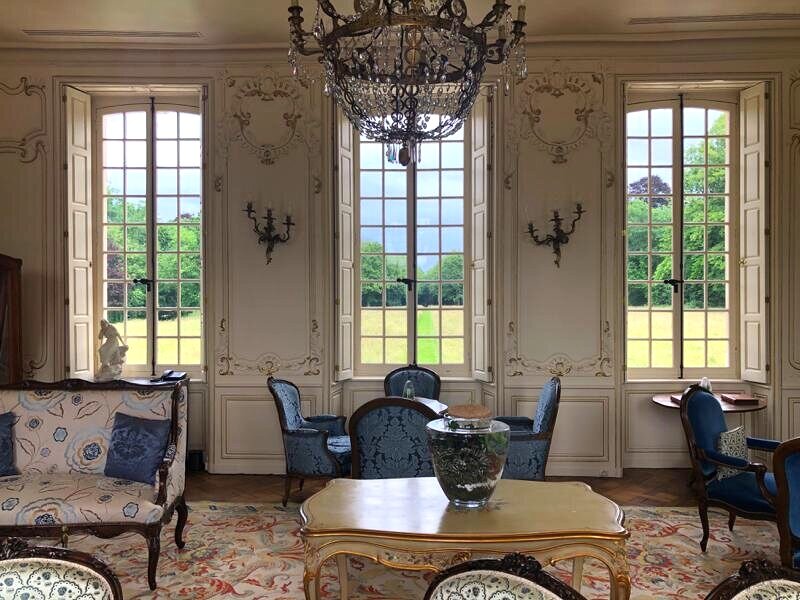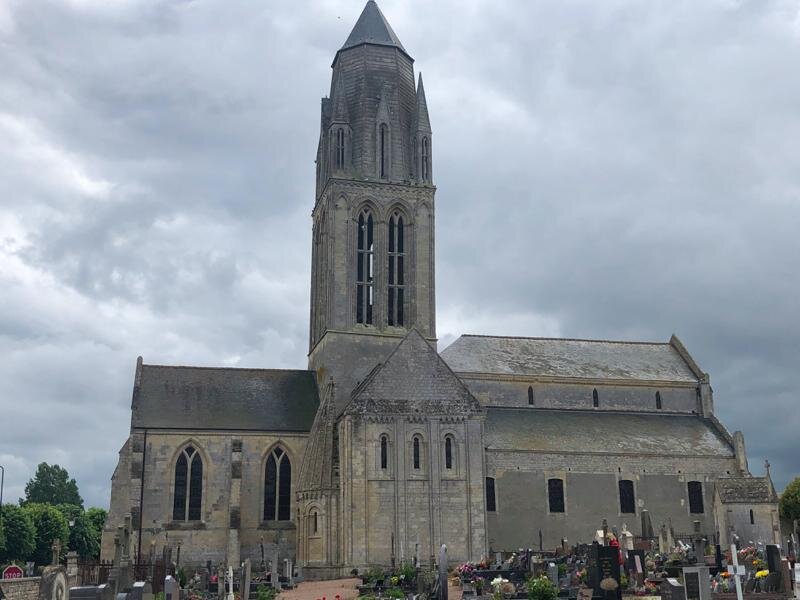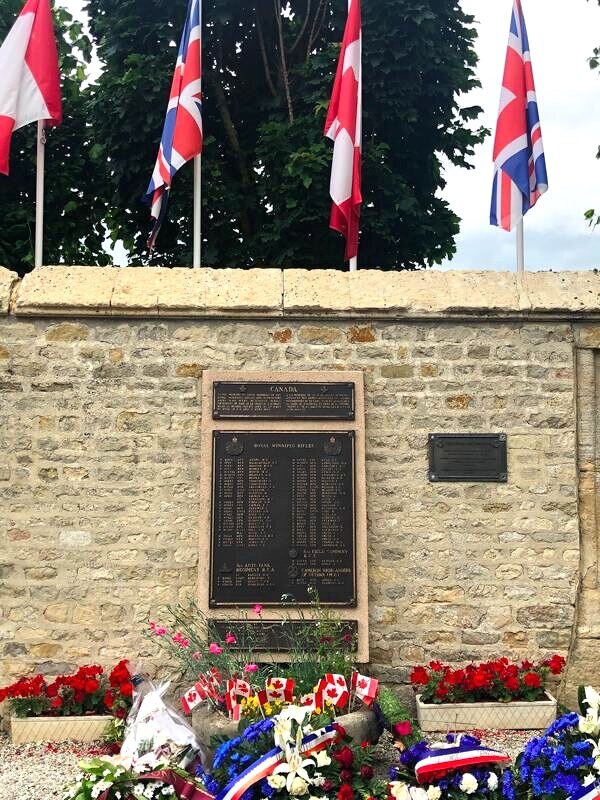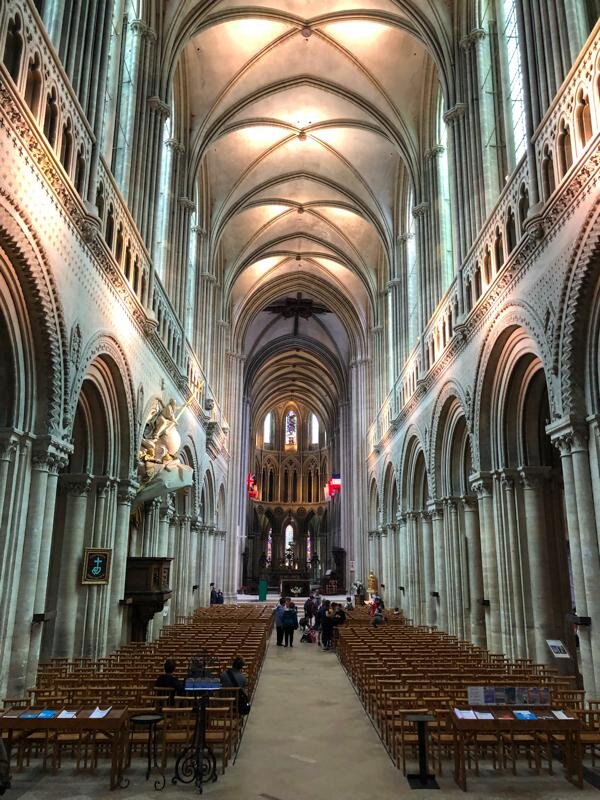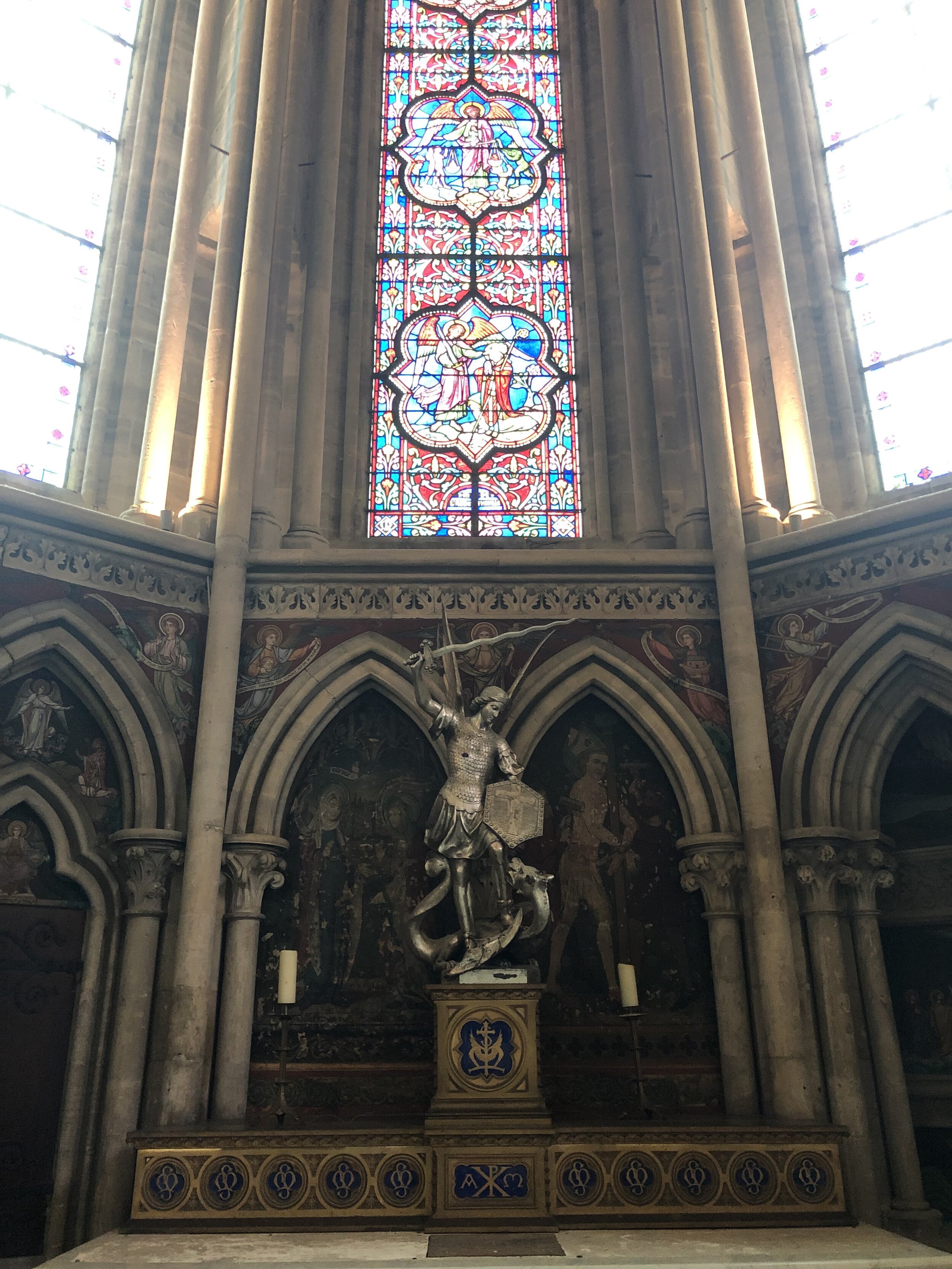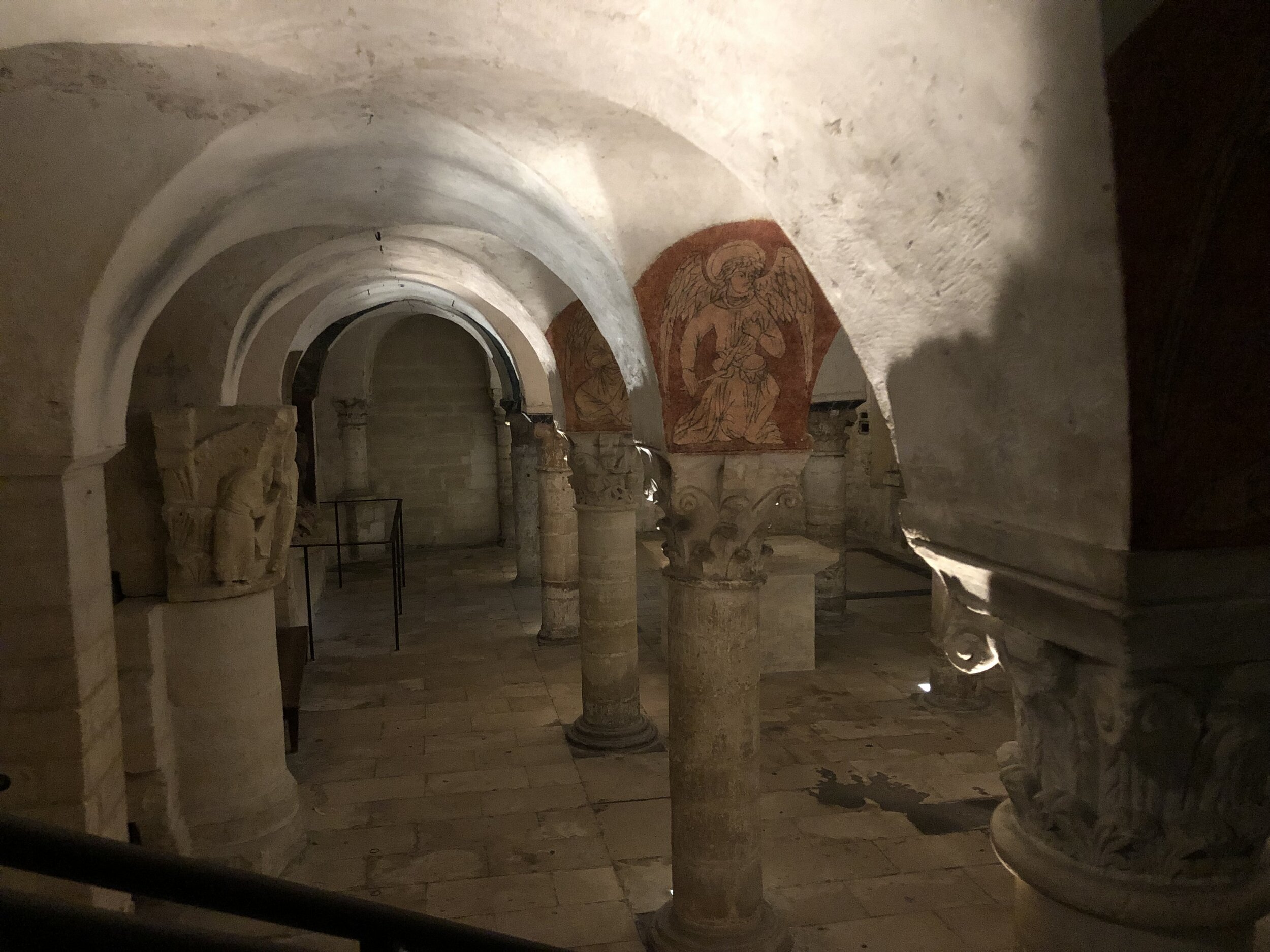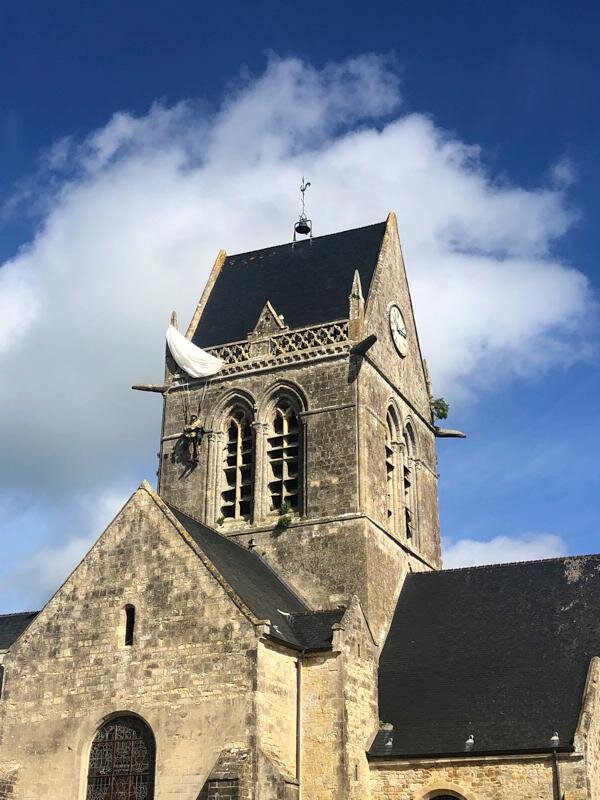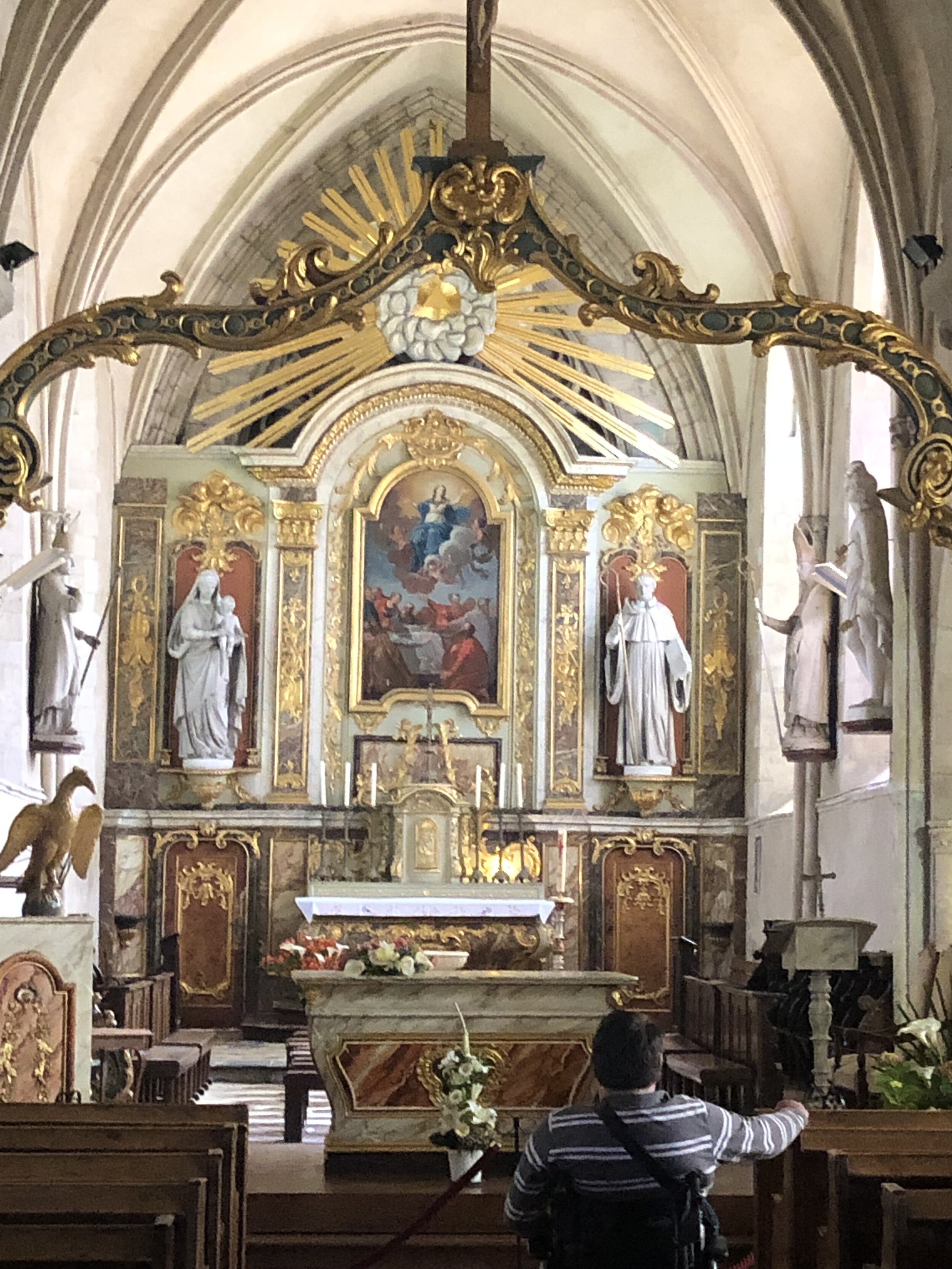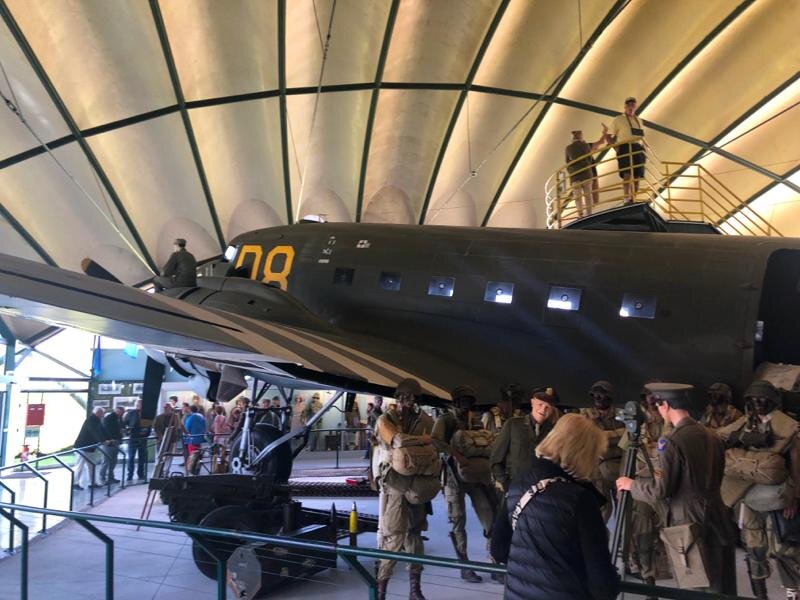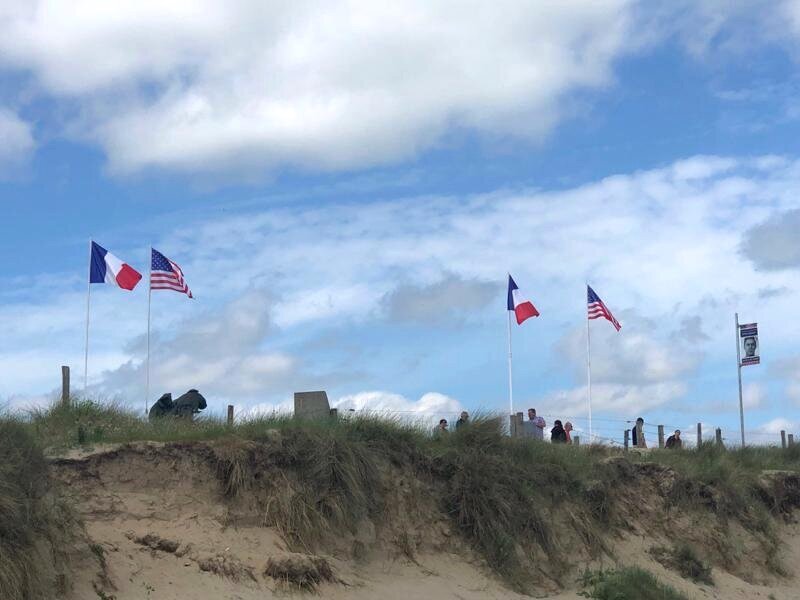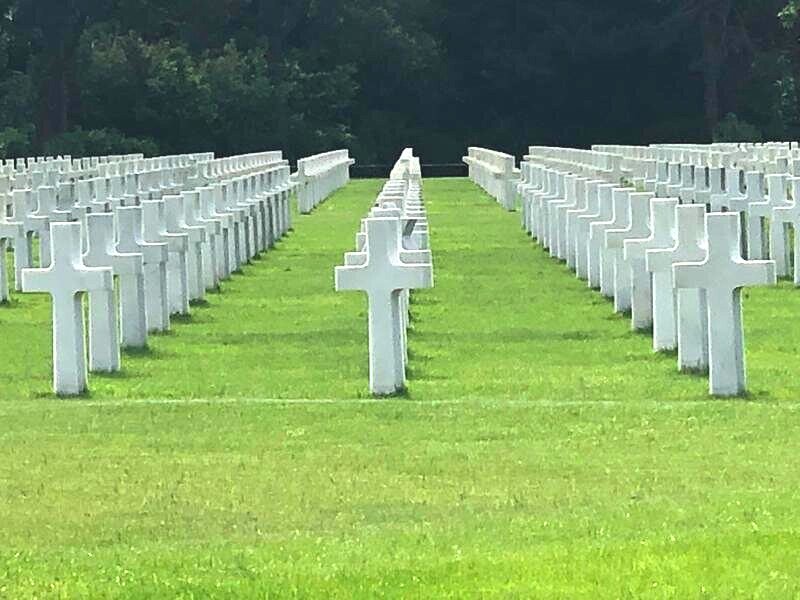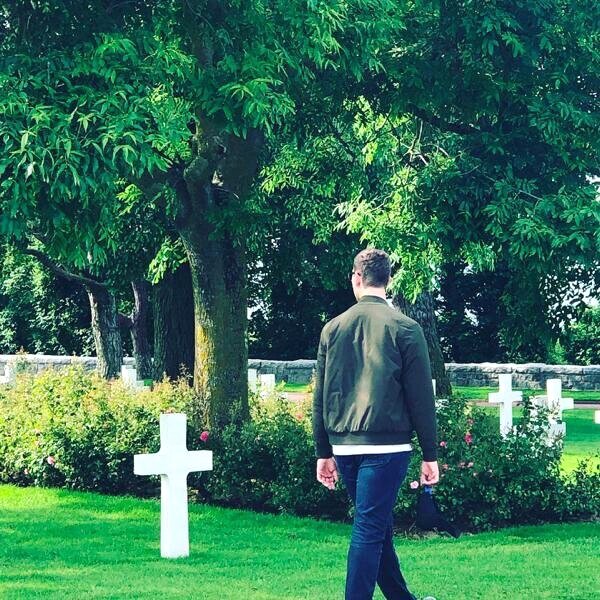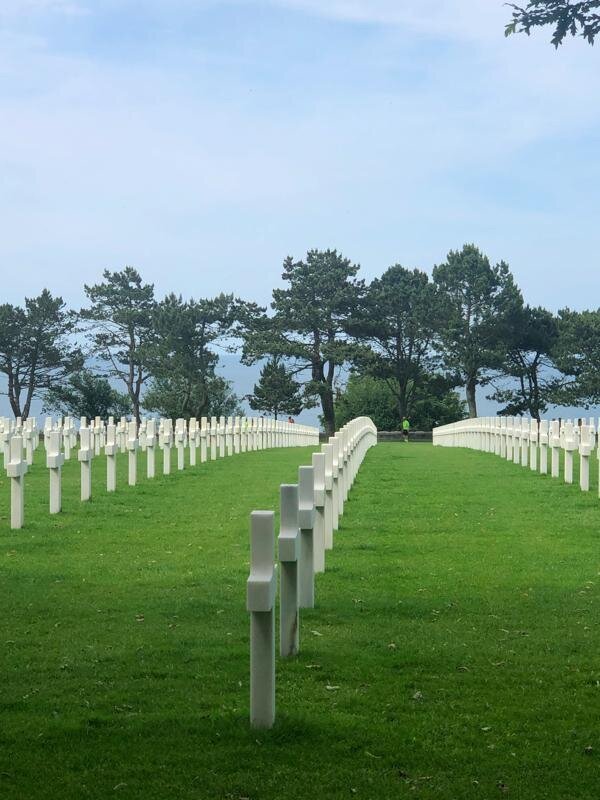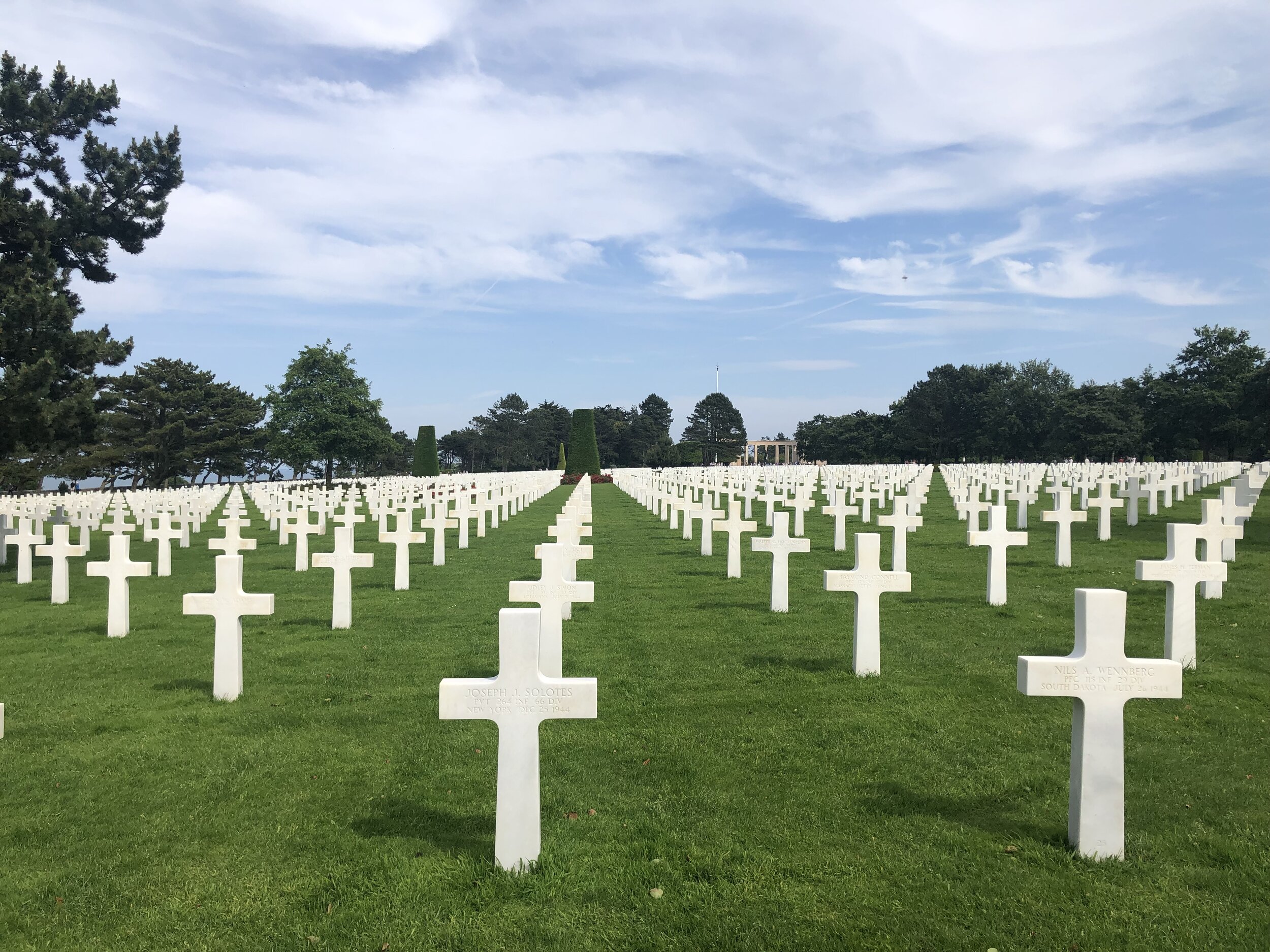Visiting Normandy, France
Being a big art history and history buff, the 75th anniversary of the D-Day invasions was fascinating to me. In addition to World War II, Normandy is rich in so much other amazing history and sights- ranging from the Middle Ages to today. Having been to Paris and other parts of France, Normandy had been high on my list. So, we decided this would be the year to explore this incredible area of Northern France.
Chateau D’Audrieu
After arriving at Orly airport, a quick 2-hour drive brought us to the beautiful Chateau D’Audrieu, a gorgeous 18th century chateau owned by Relais & Chateaux. Located in the countryside between Bayeux and Caen, the Chateau looks like its right out of a French postcard. This historical monument was built in the 18th century. The property is set on 62 acres of parkland featuring 3km of running paths and 12 gardens- a French, an English, a White and a Rose Garden, to name a few. The hotel also has a small spa and pool. We felt like members of the French nobility our entire stay. The Chateau is located about a 5-minute walk to the tiny town of Audrieu which is comprised of a few Gallo Roman houses and the Gothic Church of Notre Dame D’Audrieu. The church is surrounded by a cemetery with some of the most beautiful and interesting grave stones.
Canadian War Memorial
The Chateau survived World War II since the 12th SS German command unit commandeered it for their headquarters. Since the Chateau is located 10 minutes to Bayeux and 20 to the coastline it was an excellent location for a command center as well as being a beautiful building. Sadly, the Chateau did play a role in a sad event during the D Day operations. On June 8, 64 Canadians from the Royal Winnipeg Rifles Unit were taken prisoner by the Germans in the village. At the end of a 45-day imprisonment, the Canadians were executed by the Germans. After the War 5 of the SS commanders were prosecuted for this war crime. A lovely tribute monument to these 45 brave Canadians stands in the center of Audrieu and was clearly still lovingly taken care of!
Since the hotel was located about a 10/15 minutes-drive to Bayeux, a lovely medieval town, we spent a lot of time there. I fell in LOVE with Bayeux! The city’s history has long been marked by various wars throughout the centuries. The town is located on the Aure River about 10km from the Channel Coast and D-Day beaches. The medieval center is so charming with cobblestone streets, half-timbered houses and some incredible sights. The town survived World War II relatively unscathed due to a strong resistance group who drove the Germans out of the town on D-Day. Thus, the Allies had no need to bomb the town from the sky. As a result, Bayeux was the first town liberated on June 7, 1944. It became a major transit hub for the Allies who built a bypass road since their machinery and tanks wouldn’t fit on the tiny medieval streets. The town also served as the hospital for many of the injured Allied forces as well as refugees. On June 14, 1944, General Charles de Gaulle arrived in Bayeux giving his first speech which legitimized his place as the Leader of Liberated France. For a brief time in the summer of 1944, Bayeux was the capital of France; this transferred to Paris when it was liberated on August 25.
View of Bayeux Cathedral
In addition to holding a critical role in the D-Day and World War II history, there are two must see medieval sights to visit while in Bayeux- the Cathedral Notre- Dame and the Bayeux Tapestry. I couldn’t wait to see both! The Cathedral Notre Dame (or the Cathedral of Our Lady of Bayeux) reflects Norman, Romanesque and Gothic architecture. The church is located in the heart of town. It was on this spot that Harold II (the Anglo-Saxon King) under the command of William took an oath to marry William’s daughter. This oath and consequent marriage helped to solidify the Duke of Normandy’s chance to take the English Crown. Harold, however, broke the oath and shortly thereafter the Battle of Hastings occurred in 1066. After a very hard fought battle, William won the battle and became King. This was a very significant moment in history; Anglo Saxons had ruled England for 600 year. With his victory, England fell under Norman rule for the first time. The Cathedral was consecrated on July 14, 1077 in the presence of William the Conqueror (aka The Duke of Normandy and the King of England).
Apse of Bayeux Cathedral
Walking through the church is truly awe-inspiring. The original Romanesque structure was damaged in the 12th century; it was then rebuilt in the Gothic style. The only Romanesque features to remain are the crypt and Western façade towers. The cathedral suffered much pillaging and destruction during various rebellions and the French Revolution. The Cathedral as we see it today was a result of extensive renovation in the 18th century. Regardless, the 9th century crypt, the tower columns, vaulted ceilings, amazing stained glass are beautiful!
Our next medieval stop was the Bayeux tapestry. Even for non-history and art lovers, this tapestry is astounding. The Tapestry is not actually a tapestry but rather a hand stitched embroidery using colored wool yarn. Displayed in a u-shaped glass case, visitors are given headsets that tell the story of the events leading up to the Battle of Hastings in 1066 and the Norman Conquest. The story is told and depicted from the point of view of the Normans. The tapestry is a staggering 9 centuries old and is listed on the UNESCO Memory of the World list. It is exquisite and a must see.
Para Trooper Window
After visiting Bayeux, it was time to visit the coast and beaches. The D-Day invasion (code named Operation Neptune) was the largest amphipean military operation. 150,00 soldiers landed on the beaches. The original date was June 5th but due to weather the operation was delayed. We began our tour of the beaches at Sainte Mere Eglise which occupied a key strategic location on the road to Cherbourg (a major port in Normandy). It was the first town liberated by the US Paratroopers of the 82nd and 101st Airborne. It’s particularly famous for one American paratrooper, John Steele. John Steele landed in Sainte Mere Eglise but as he descended got caught in the church steeple. He hung there playing dead for over 2 and half hours. He was eventually captured by the Germans but was later able to escape. The stained glass window in the church was one of my favorites as is paid tribute to the paratroopers who liberated the town! There are several incredible museums here where we were able to walk into a paraglider , a plane, tanks and view other tools and equipment the paratroops used. Mere Eglise is located about 1 mile from the beach so that is where we headed next.
After visiting Mere Eglise, we headed toward the beaches. The five beaches were divided into sectors each given a code name: Utah, Omaha, Gold, Juno and Sword. I was struck by how far apart all of the beaches were; they spanned 50 miles. We visited Utah, Omaha and Gold. Standing on each beach was very moving. Today they are wide beautiful expanses of sand. It’s hard to imagine what it was like during the war. But despite the peaceful feeling, there was plenty of evidence of the invasion. At the entrance to Omaha, is a mock boat similar to the boats the Allies used to land. Omaha had the bloodiest beach battle which sat in the American zone. Located at the foot of very steep cliffs, the first few waves of the Allied forces were easily gunned down by the Germans who sat in bunkers on the cliffs. Despite the rough surf, low tide and the enormous odds stacked against them, the Allies didn’t give up and slowly made headway. After scaling the cliffs, they had gained 1.5 miles of land by night despite losing so many troops.
At Gold Beach (in the British zone) we were in awe of the remnants of Mulberry harbor. After the landings, the allies needed a harbor to bring more troops, machinery, and supplies. So, each segment of the docks of Mulberry Harbor were built in England. Ships then brought them across the channel. In order to keep the segments a float each piece was connecting and filled with water. The ingenuity and brilliance gave the Allies a full working harbor by mid-June. I could write an entire story about the beaches, the details of the invasion, the aftermath! But none of that can truly convey the feeling of walking on the sand feeling the peacefulness and the beauty. One local told us visitors often ask how can people swim and enjoy the seaside knowing how many died there. The local’s response is this is what all of the brave people died for and would want- to see people today enjoying the beauty. To this day, the people of Normandy remember and are grateful.
Our visit to Gold Beach was a highlight for all of us. We drove out to the beach with a guide in a vintage World War II jeep that had been restored and was fully functional. Driving on the roads in the open air and rain really gave us a sense of how the Allies felt as they traveled around Normandy! Definitely a fun way to learn history while riding in something from that time!
Our World War II Jeep
The Cliffs by Gold Beach
A Veteran’s Tribute at the American Cemetery
After spending time at the beaches, we moved on to visit the American Cemetery at Colleville-Sur-Mer and the Commonwealth Cemetery of Ryes- Bazenville. The American Cemetery was established on June 8, 1944 overlooking Omaha Beach. The French government gave the 172.5 acres to the Americans for free and with no tax. There are 9,300 graves, a chapel and a beautiful garden. Of the 9,300 graves only 4 are women. Theodore Roosevelt Jr. (the President’s son) and Quentin Roosevelt (the President’s brother) are buried there, as two of the Niland Brothers (whose family story was depicted in Saving Private Ryan) Walking through the cemetery with its perfectly aligned and symmetrical crosses is a beautiful, touching experiencing. The crosses featured just a name in simple writing. Despite the large number of graves, this is a small number of those who perished. Most bodies returned home to be buried. At 5:00pm we had the privledge to watch the flag ceremony where not only did “Taps” play but a veteran was present to take down the flag. It was beyond moving; there was not a dry eye in the crowd. The cemetery conveys a sense of beauty, solitude, and pride. To see all of the lives lost in this fight for freedom is truly inspirational.
In contrast to the vastness of the American cemetery, the British Cemetery emanates a sense of peace unlike anything I experienced. Set on a quiet road amidst beautiful fields, the cemetery holds 4,648 British, 338 unknown soldiers, and 500 soldiers from various countries including Poland and Germany. Walking around I was struck by the beautiful sayings that had been engraved on each and every cross. The words were so touching and made the deaths of these soldiers more personal. Visiting both cemeteries was very moving; both my kids at their young ages could even feel the enormity of what we were seeing. We were all glad to have paid our respects to all of these brave soldiers.
The British Cemetery
A visit to Normandy is a must for any history lover. It is a very emotional trip for any American. The countryside, history and towns of Normandy are astounding. I loved the mix of medieval history and World War II history. I was wowed by the towns and thrilled to have experienced a part of the France that paid such a pivotal role in world history.


